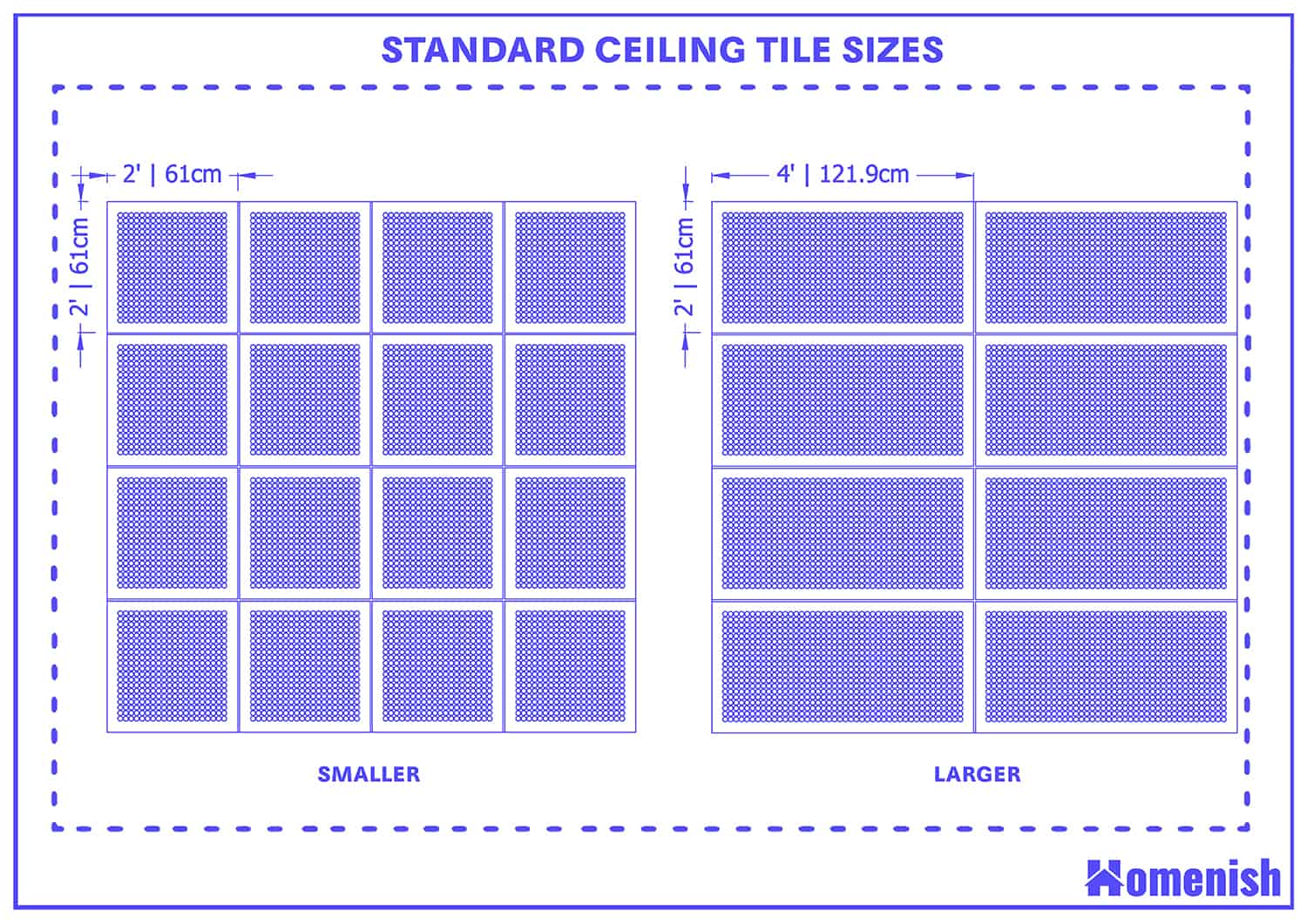Ceiling tiles are commonly used for drop-down ceilings in commercial and residential properties. These types of ceilings are used for a variety of reasons, and they can be made from numerous material types. The one thing these tiles have in common is their size.
They come in just two standard sizes across the board, making it easy to get replacement tiles if you need to and also making it much simpler to measure and plan for a drop ceiling project in your room
Ceiling Tiles Sizes
Ceiling tiles come in just two standard sizes. The smaller size is 2 feet by 2 feet, which equates to 24 inches by 24 inches, or 60cm by 60cm. The larger size is 2 feet by 4 feet, which equates to 24 inches by 48 inches, or 60cm by 120cm. This means you can choose from either square ceiling tiles or rectangular ceiling tiles.
It is unlikely that your room will be the perfect size to fit an exact amount of ceiling tiles, so you can expect to have to cut down a few ceiling tiles when you reach the final edge of your room.
What is a Drop Ceiling?
A drop ceiling is also known as a drop-down ceiling and a dropped ceiling. These are secondary ceilings that are added to an existing ceiling structure, creating a lower ceiling height. They remain the ceiling type of choice in offices and commercial buildings such as stores, but they can also be seen in residential settings as well.
They are less commonly seen in homes than they once were, as people don’t find them to be very aesthetically appealing. However, they offer plenty of functional benefits, which some people may prefer over having an attractive plastered ceiling.
Drop Ceiling Benefits
Energy efficiency
Drop-down ceilings improve energy efficiency, and this is one of the reasons why you will see a lot of drop ceilings in older homes that have original high ceilings.
High ceilings are an architectural feature that is very popular, and it was widely used in the construction of older homes. However, when people realized that it costs a lot of money to heat such tall rooms, they opted to install drop ceilings as a way to cut energy costs.
Since heat rises, tall ceilings also meant that all the hot air in the room was wasted being up high where nobody could benefit from it. Drop ceilings mean that heat is condensed into a smaller space at a lower ceiling height where people will be more likely to feel it.
While drop ceilings also create a lower ceiling and therefore a smaller space to heat, they also work as an additional layer of insulation, preventing heat from escaping out of the ceiling, as well as preventing cold air from getting into a room.
This means that people in a room with a dropped ceiling will benefit from a more comfortable temperature, and the cost to heat the home will also be reduced. Drop-down ceilings are also great in warmer months since they keep air-conditioned cool air in the room and stop hot air from above from getting into the room.
Easy installation
One of the things that many people love about drop ceiling tiles is how easy they are to install. You don’t need to pay a professional to install a drop ceiling because the process is easy for most amateur DIY enthusiasts to complete by themselves, and only a limited number of tools are required.
This means that you can install your drop ceiling yourself, dramatically cutting costs. The easy installation also means that the project should be completed quickly, allowing you to appreciate a sudden transformation in your space.
Fire-safe
Ceiling tiles have to be made to a certain standard of fire resistance, making them a safe option for both homes and workplaces. You have probably also seen ceilings made from ceiling tiles in areas where lots of people congregate, such as schools and church halls, so it is reassuring to know that these types of ceiling materials are not susceptible to fire.
Easy access
One of the reasons why drop-down ceiling tiles are so popular in offices and commercial buildings is because they provide easy and convenient access to important pipes and cables which are hiding beneath them. This means that any maintenance such as leaking pipes or electrical issues can be easily remedied by simply removing one or two of the tiles to gain access to the necessary area.
By contrast, if you had to cut holes into a plastered ceiling every time there was a maintenance issue, the cost and the disturbance would be huge.
Wide choice
Ceiling tiles were once only available in shades of gray, beige, and white, but now the choice has been extended to include a wide variety of styles and colors. You can get ceiling tiles that have been designed to look like they are made from solid gold, with intricately detailed patterns, or tiles that have leaves printed on them to create the illusion that you are sitting beneath a rainforest canopy.
Inexpensive
Ceiling tiles are an inexpensive solution if you want to hide an old-fashioned ceiling or improve your energy efficiency. They do not cost very much to buy, and if you install them yourself, you will complete the project for a low price.
Hides imperfections
Ceiling tiles for drop-down ceilings can hide a range of flaws on your original ceiling that you might not want to look at every day.
If you have had to have some of the house re-wired or some new pipes installed for a renovation, then you might have these running along the ceiling, and hiding them with a drop ceiling is the easiest and most cost-effective option. You can also opt for a drop ceiling to hide old-fashioned spackled ceilings or ceilings that are stained with nicotine from previous owners smoking indoors.








